Adding hydropower facilities to nonpowered dams is an increasingly popular way to create new noncarbon power generation resources without having to build new reservoirs or dams. Missouri River Energy Services (MRES), a joint action agency that brings together 61 municipal utilities in the upper Midwest, recently added a hydro plant to the federally owned Red Rock Dam on the Des Moines River in Iowa. In this interview, we speak with Brent Moeller, MRES’s director of generation resources, and Ray Wahle. MRES’s senior vice president of power supply and operations, about the challenges and benefits of the Red Rock Hydro Project (RRHP).
Hydro Leader: Please tell us about your backgrounds and how you came to be in your current positions.
Brent Moeller: I’ve been with MRES since 2008. I serve as the director of generation resources. I am a registered professional engineer in the state of South Dakota. I originally started out in the utility business and worked at a nuclear facility for 12 years. I then moved into project management with industrial pumps, steel fabrication, and things of that nature before coming back to the utility business again about 12 years ago. That’s how I got here.
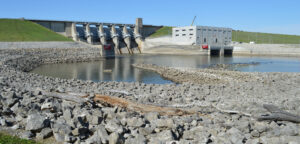
Ray Wahle: I’m the senior vice president of power supply and operations at MRES. I’ve been here for 42 years. I started after I graduated from college with a degree in electrical engineering. I am a registered professional engineer in the state of South Dakota and have an MBA. In my 42 years at MRES, I’ve filled various roles of increasing responsibility. I am responsible for the operations, maintenance, and construction of our power plant and transmission facilities. We serve 61 municipal utilities located in Iowa, Minnesota, North Dakota, and South Dakota. MRES provides other electrical services to those communities as well.
Hydro Leader: Please tell us about MRES as a company.
Ray Wahle: MRES is a joint action agency, which means that we were formed by and are owned by our members. Our members are the 61 municipal utilities I mentioned. Each one of those member communities owns its own electrical distribution system. Our primary function is to provide power supply, energy, and transmission services to those members. Over the years, we have developed a suite of other energy services that we provide to them as well, including energy efficiency rebate programs for their customers, rate studies for the utilities themselves, and distribution maintenance crews to support communities that need help delivering reliable services. We also have a host of technical services and other support services for our members.
Hydro Leader: How is MRES’s power generated?
Ray Wahle: We have a diverse portfolio of generation resources, including facilities powered by coal, gas, oil, wind, solar, and hydro. Thirty-four percent of our supply comes from market purchases—buying energy is sometimes cheaper than producing it ourselves. According to our 2018 yearly breakdown, we produce about 15 percent of our energy from coal, about 2 percent from natural gas, 5 percent from nuclear, 36 percent from hydro, 5 percent from wind, and less than 1 percent from solar; the remaining 34 percent comes from market purchases of power generated by others. The 36 percent that comes from hydro is energy that MRES manages for our members. Fifty-nine of our 61 members have an allocation of hydropower from the federal dams on the Missouri River, which is supplied to them through the Western Area Power Administration.
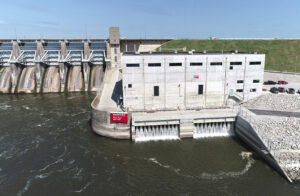
Hydro Leader: When did the idea for the RRHP arise, and what was the motivation?
Ray Wahle: In fall 2010, I got a phone call from a gentleman by the name of Doug Spaulding, who worked for a company called Nelson Energy and had gotten my name from a mutual colleague. He presented the idea of MRES developing a hydro project on the Des Moines River—the RRHP. At that time, MRES was looking for additional resources. We have the obligation to supply our 61 member communities with power to meet their electric energy needs. As the communities grow, we need to provide more and more power. Of course, we were interested in looking at renewable resources. At that time, Nelson Energy held a preliminary permit for the development of the RRHP and had applied to the Federal Energy Regulatory Commission (FERC) for a license to develop it.
Nelson Energy is a small organization and did not have the financial ability to develop the project. It was looking for a partner. We started looking at the RRHP from an economic standpoint, evaluating whether it would meet our future electric supply needs and recognizing that it was a renewable resource. Based on our analysis, we felt that the project would meet our long-term need for additional electric supply, and we made the decision to develop the project. Once we got the FERC license, we started the design and the construction of the project.
Hydro Leader: Who owns the Red Rock Dam, and what was their attitude toward the idea of adding hydropower to it?
Ray Wahle: The dam is owned by the federal government and operated by the U.S. Army Corps of Engineers. Dealing with the Army Corps was new for us, and initially, it was a challenge to understand how the Army Corps worked and operated. FERC was also involved in the process. After we developed a working relationship with the Army Corps, and the Army Corps got used to the idea that we were going to build a hydro project at its dam, it was a cooperative partner. The Army Corps has its own process and requirements,
and we had to recognize that. Brent worked more directly with the Army Corps than I did. Our relationship with the Army Corps is ongoing, because it still controls the flows going through the power plant and coming out of the dam and controls water releases from the Red Rock project.
Brent Moeller: We have a good working relationship with the Army Corps operations folks at Lake Red Rock and with the Rock Island District, the headquarters for the operational folks at the Army Corps. We interact with its flow division daily, communicating about the flows that it will be releasing for the day. We will continue to work closely with the flow division, which I think is excited to see the hydro project there now. As Ray mentioned, we had to get used to the Army Corps’ process. Of course, the Army Corps had a lot of concerns about an unknown company coming in and about the condition in which we would leave the facilities or the area. I think that now that construction is complete, the Army Corps is happy with everything that we did and with the current situation.
Hydro Leader: Who owns and operates the hydropower facility itself?
Ray Wahle: The intake structure, the penstocks, the power plant, and all the equipment in the power plant is owned by the Western Minnesota Municipal Power Agency. MRES constructed, operates, and maintains the project on its behalf.
Hydro Leader: What made the Red Rock Dam appropriate for adding hydropower?
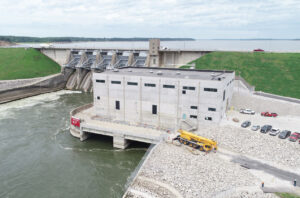
Ray Wahle: A combination of things. The first, of course, is that the dam already existed. Second, the timing of water releases at the dam, and thus the power capacity and energy we can get out of the facility at different times, fit with our power needs. The Red Rock Reservoir is a flood control reservoir. In the spring, the reservoir fills up with snow melt and spring rains and the Army Corps holds back the water. The Des Moines River drains into the Mississippi River, and the Army Corps wants to control the amount of water going into the Mississippi River to prevent downstream flooding. The Army Corps starts releasing water in the late spring and releases it throughout the summer. In the electric utility industry, we need more power in the summer than in the winter. As long as there’s flow in the Des Moines River, the RRHP will generate power year round, but it will generate the bulk of its energy in the summertime, exactly when we need it. It matches our electric load needs.
Hydro Leader: Please tell us about the timeline of planning, permitting, and constructing the project.
Brent Moeller: Doug Spaulding of Nelson Energy started going through the FERC licensing process for this project back in 2005. That process usually takes about 2 years and includes studies and public meetings. When Doug came to us, he had submitted the application and it was pending being issued. Nelson Energy received the FERC license in April 2011. At that point, we purchased the rights to the project and the license and started doing a more detailed design of the facility. A 5 or 10 percent design was done for the licensing process, so there was a limited design for the facility. We spent the next 2 years or so going through the design process. In addition to that, around 40 different plans were required for the FERC license. For example, we couldn’t cut trees during the summer to avoid affecting the Indiana bat.
Part of the design involved bringing on the turbine design manufacturer, because the powerhouse is designed around the hydraulics of the turbines. In April 2012, we signed a contract with a turbine manufacturer to provide the water-to-wire-package. In August 2013, we submitted our 408 application to the Army Corps, which is a review of the complete design of the powerhouse and of the projects, dealing with the walls and different civil structures associated with the project. It took several months for that application to be approved, and we issued a contract to the general contractor in April 2014. We received final authorization to start construction from the Army Corps on July 28, 2014, and we released the general contractor to start construction on August 1, 2014. Construction took place from August 2014 to October 2020.
We are currently commissioning the units. As Ray mentioned, the bulk of the water comes down during the summer. However, during the review of the project, we learned that once about every 8–10 years, there is not adequate water to operate the turbines. Last year, we didn’t have much water, and as a result, the Des Moines River did not really flow sufficient quantities of water to operate the turbines throughout the winter. Now that we’ve gotten a little bit of snow melt, we’re back to commissioning the units again. We anticipate that that will last for another 2–3 weeks, at which point they will do a 30‑day test run on both units. After that point, we’ll go into commercial operations.
Hydro Leader: Once the RRHP is running at full capacity, how much energy will it produce, and how will that power be distributed and marketed?
Ray Wahle: It will produce 180,000 megawatt-hours a year. The facility is located in the market area of the Midcontinent Independent System Operator (MISO), which is a regional transmission operator in the United States. The market area basically goes from the Canadian border to the Gulf of Mexico and runs down through the center of the United States. The RRHP is located in the center of the MISO. We deliver our energy to that market, and there’s a complex financial arrangement that governs how we eventually get that energy to our members in Iowa, Minnesota, North Dakota, and South Dakota. More to the point, the members of MRES are financially responsible for paying the costs associated with the RRHP and get the benefits of the energy that is generated by it.
Hydro Leader: Does MRES have plans for any similar projects in the future?
Ray Wahle: We have no plans for anything similar. We are looking at developing other resources, but none like the RRHP.
Hydro Leader: Does this project provide a model for adding hydropower to other nonpowered dams across the nation?
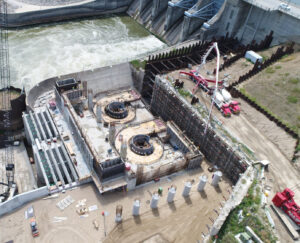
Ray Wahle: We worked with the Army Corps to develop the project, and that process can certainly be repeated with other nonpowered dams where it makes economic sense to add a hydro unit. One of the challenges is that hydro units are fairly expensive. However, they also have long lives. Over time, the RRHP will definitely pay for itself, but it had a high initial capital cost.
Hydro Leader: What advice do you have for other power agencies that are considering powering a nonpowered dam?
Brent Moeller: Do your homework and develop a relationship with the Army Corps. It is your partner in this. Keep in mind that it’s the Army Corps’ sandbox, and you’re coming to play in it, so to speak. You need to develop a rapport with the Army Corps. You can’t bulldoze your way through; it needs to be a working relationship. Also, you’re going to spend more money than you anticipated because the Army Corps is going to want to add more security and safety than you originally anticipated. There might be additional costs, but at the end of the day, it’s a matter of getting the project built and operational.
Ray Wahle: What allowed us to be successful was developing a great relationship with the local community. Pella, Iowa, is about 3½ miles from this project. It turned out to be one of our members, which was fortuitous. We have an employee at Red Rock who helped build community relationships that really helped us. We had nothing but positive comments from the community. A construction project of this nature is invariably disruptive to the area. Developing a good relationship with the community, the county, the county police force, and the county sheriff is important. For example, we had to work with those entities to close the roads for construction.
Brent Moeller: One of the things that we’re looking at doing after the COVID‑19 pandemic is holding an open house for the local community. We’ve gotten calls from people who want to tour the facility, and we constructed the facility with a meeting room set up as a classroom so that we can bring in school groups as a way to give back to the community.
Hydro Leader: Is there anything else you wanted to add?
Ray Wahle: It was really an interesting project. We’re engineers, and the reason you go to engineering school is to do a project like this. It’s something that we both enjoyed doing.
Brent Moeller is the director of generation resources at Missouri River Energy Services.
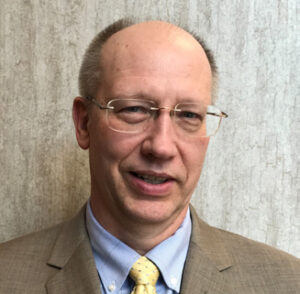
Ray Wahle is the senior vice president of power supply and operations at Missouri River Energy Services.

Both gentlemen can be contacted at (605) 338‑4042.
For more information about the RRHP, visit www.redrockhydroproject.com.
